Data has become an integral part of team and opposition analysis in the modern game. Creating a repeatable and automated process can quickly identify trends and insight, saving valuable time for the busy analyst. Teams and federations use StatsBomb IQ to support their team and opposition analysis, exploiting edges found in the platform to secure victory over their opponents every matchday. Let’s demonstrate how this can be done by looking into the England vs Denmark semi-final at Euro 2020.
England
First, let’s look at a selection of attacking and build-up metrics and compare England’s performances to the eight Euro 2020 quarter-finalists:
- xG (7th of 8)
- xG/shot (1st of 8)
- Shots (8th of 8)
- Counter Attacking Shots (8th of 8)
- High Press Shots (8th of 8)
- Box Cross % (8th of 8)
- Pace To Goal (7th of 8)
- Directness (7th of 8)
We know England have been a safety-first team in this tournament, rarely letting the handbrake off and often withholding a body or six from participating in the attacking phase, so it’s little surprise to see their attacking metrics compare poorly to their rivals. The big caveat is, of course, that they’ve been superb defensively, but we’ll come onto that later.
The first thing to note is England’s shooting habits.
You get the feeling that Gareth Southgate’s perfect match would be a 1-0 victory where the shot count matches the scoreline. The Three Lions have averaged just 7.6 shots per game so far in Euro 2020, the fewest of the eight quarter-finalists, but there’s been little-to-no wastage which reflects in their 0.13 xG per shot. They may not create much, but they tend to be quality chances when they do. 18/38 of their shots have come from within 12 yards of goal, with an impressive number of them coming in central areas right between the posts.
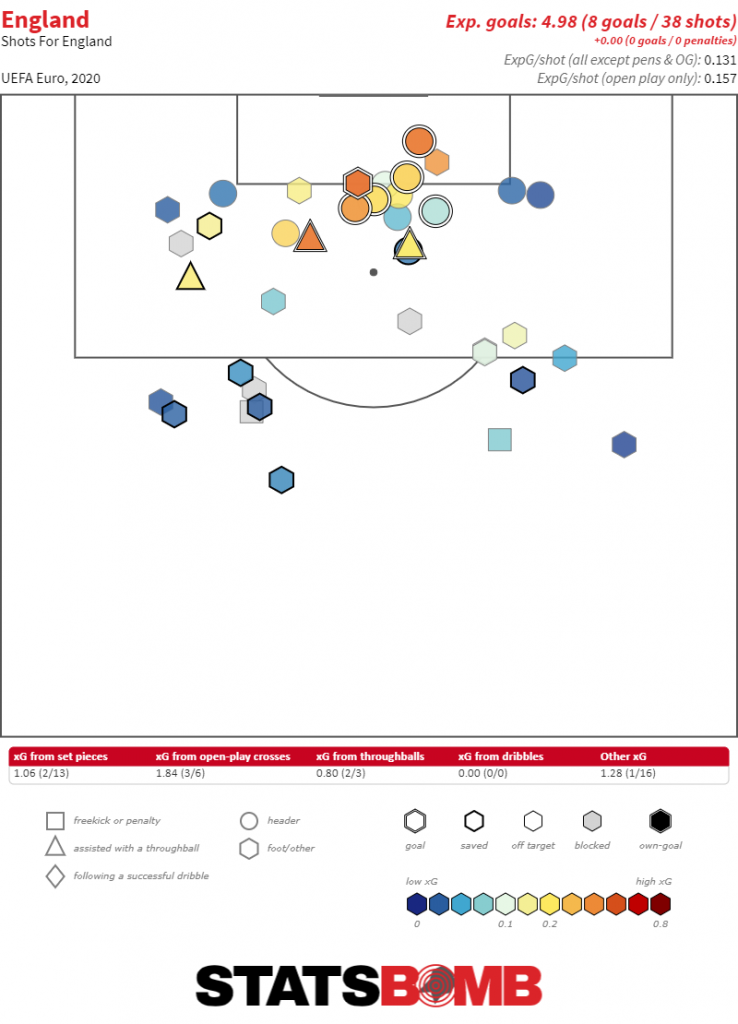
England’s build-up play has been under the microscope for most of the tournament. Those who haven’t enjoyed it may label it stagnant and sterile; others who see the bigger, risk-averse picture may describe it as comfortable. Their Pace To Goal – the speed of build-up in m/s for possessions that end in shots – of 1.95m/s was the second-slowest of the eight quarter-finalists, with England refusing to commit bodies in the attacking transition and instead looking to combination play in the advanced wide areas to plot their way to goal.
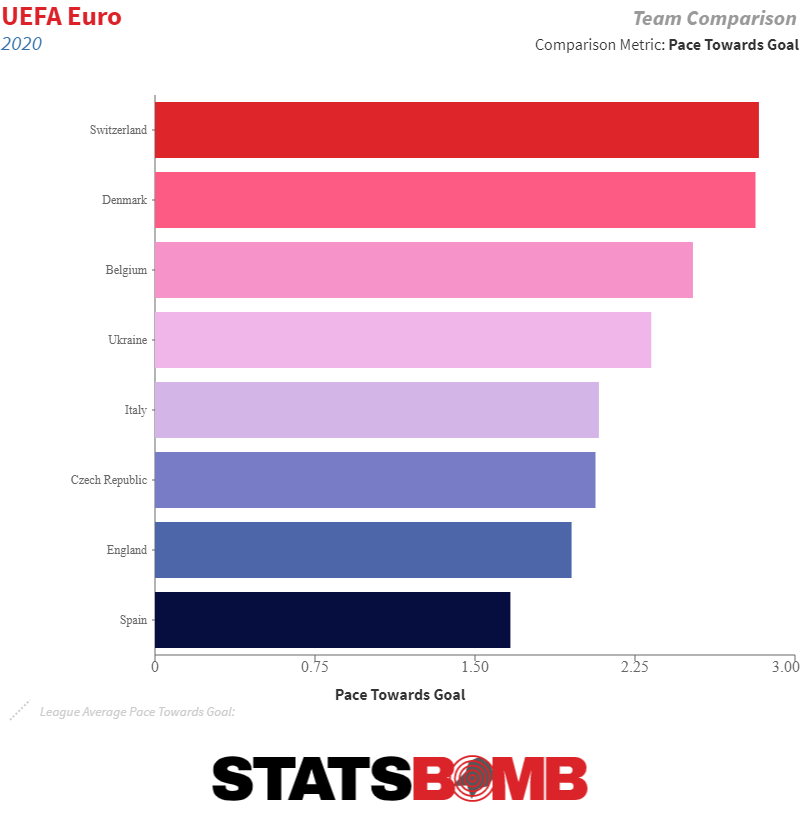
Their precise approach to build-up can be seen in their final third entries. England have passed into the attacking third 127 times in open play this tournament. Of those 127, 84 are what you would call short ground passes; the type of which England fans can probably clearly envisage should they close their eyes: the short, risk-averse pass to a nearby teammate on the wing with the opposition crowding out the centre of the pitch. You would classify few of these passes as penetrative, with England preferring to do their damage from within the final third.
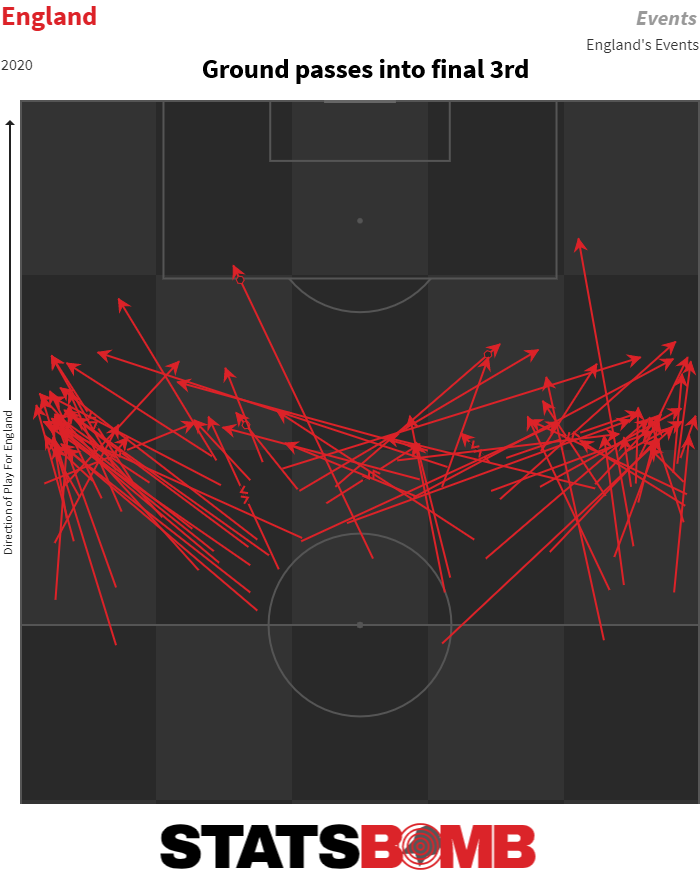
StatsBomb data contains pass height information, with High passes defined as played above shoulder height and Low passes defined as above ankle height but below shoulder height. Of England’s High and Low passes into the final third – 43 of the total 127 – there’s still little direct penetration on show, with many receptions on the wing and very few going beyond the 18-yard line. We know England take a risk-averse approach in everything they do, emphasising completing the next action in the chain towards goal, rather than spontaneous, high-risk play.
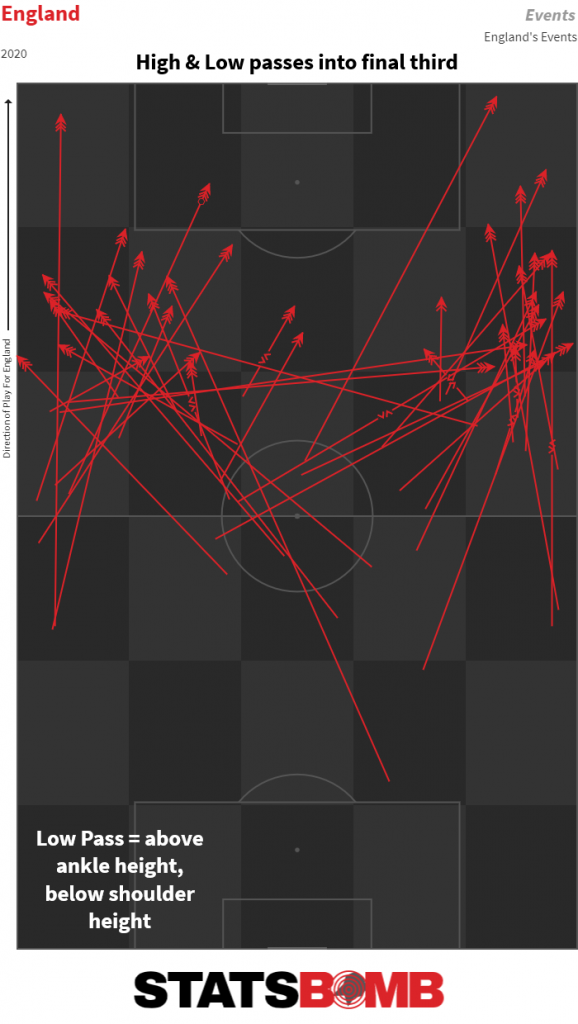
Raheem Sterling (23) and Luke Shaw (18) have been the most common recipients of passes into the final third, a left-sided lop-sided trend that continues into their box entries. England have passed their way into the opposition box 37 times in Euro 2020, 20 of which have been into the left-hand channel. Just ten came from the right flank.
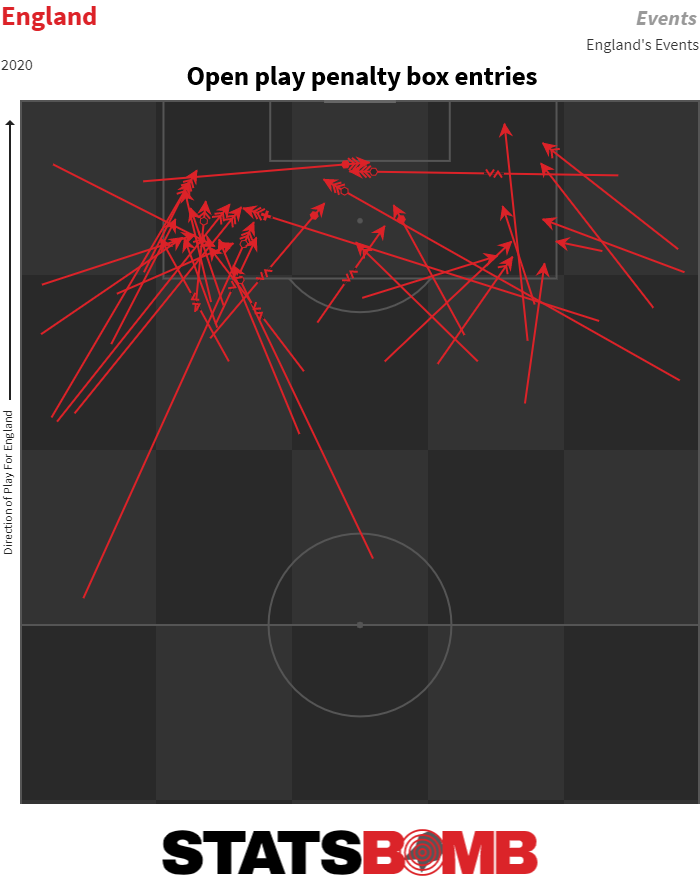 Defensive Approach:
Defensive Approach:
- xG Conceded (2nd of 8)
- xG/shot Conceded (2nd of 8)
- Shots Conceded (4th of 8)
- Counter Attacking Shots Conceded (1st of 8)
- High Press Shots Conceded (3rd of 8)
- Clear Shots Conceded (1st of 8)
- PPDA (6th of 8)
- Defensive Distance (3rd of 8)
- Aggression (3rd of 8)
- Pressures In Opposing Half % (3rd of 8)
Defensively, England have been exemplary, keeping five clean sheets in five games. They’ve defended their penalty box superbly, conceding just a couple of attempts from between the posts at close range and blocking a large percentage of shots faced.
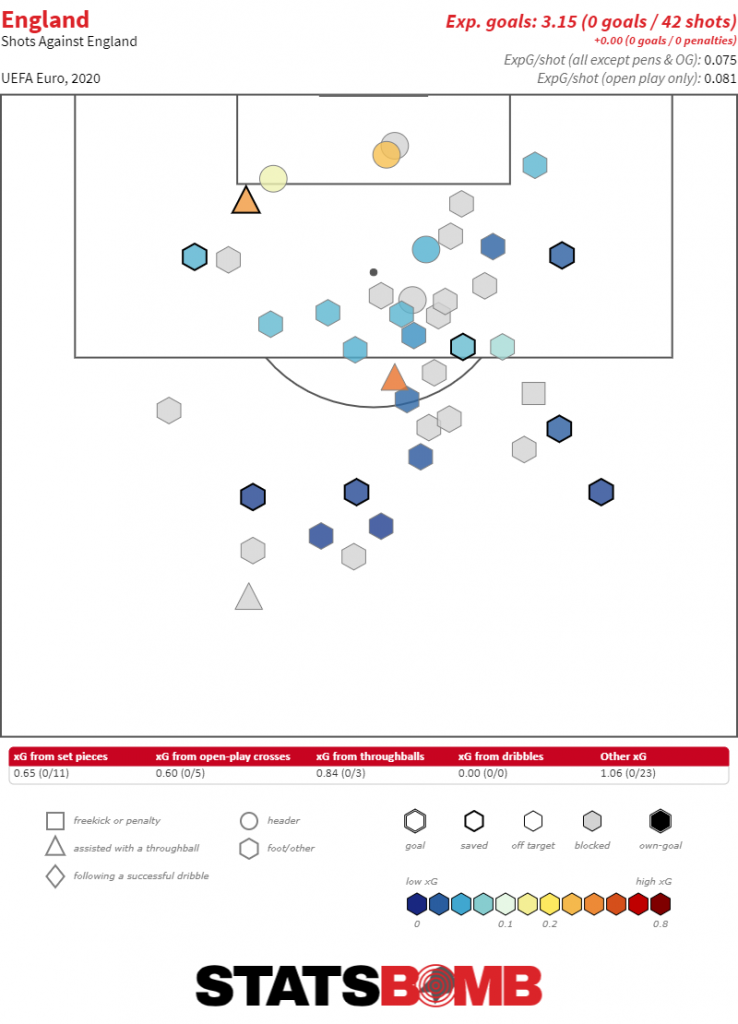
England generally look to defend higher up the pitch and have been effective in preventing the ball from reaching their danger zone too often, bombing out most opposition possessions in the middle third.
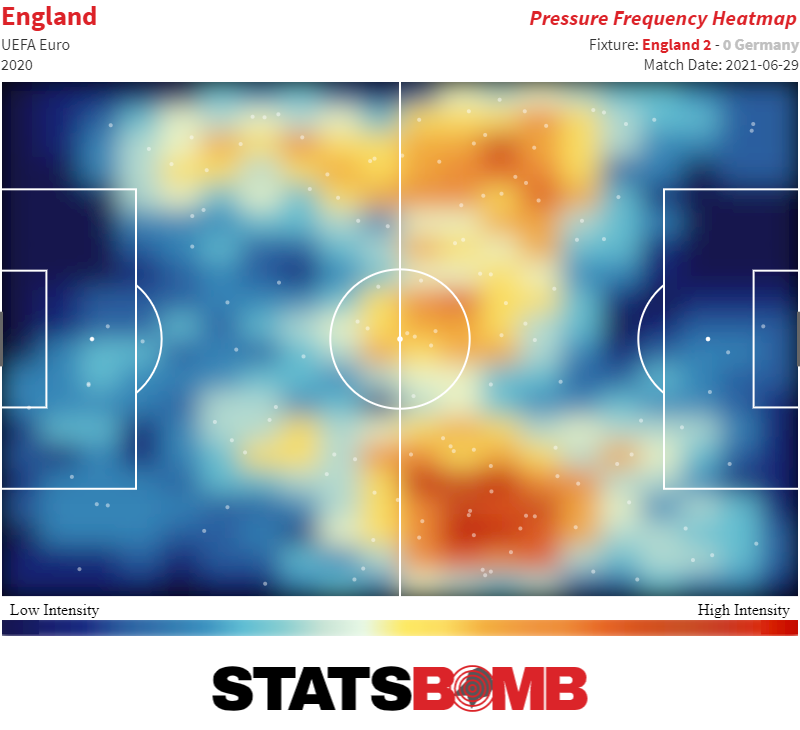
Germany caused England the most issues, creating the only two clear-cut chances England have conceded at the tournament, through Timo Werner (the shot left of the six-yard box) and Thomas Müller (the high-value shot on the edge of the box). Both chances came from England mistakes and rapid, direct transitions through the middle – something Denmark will be aware of and look to exploit.
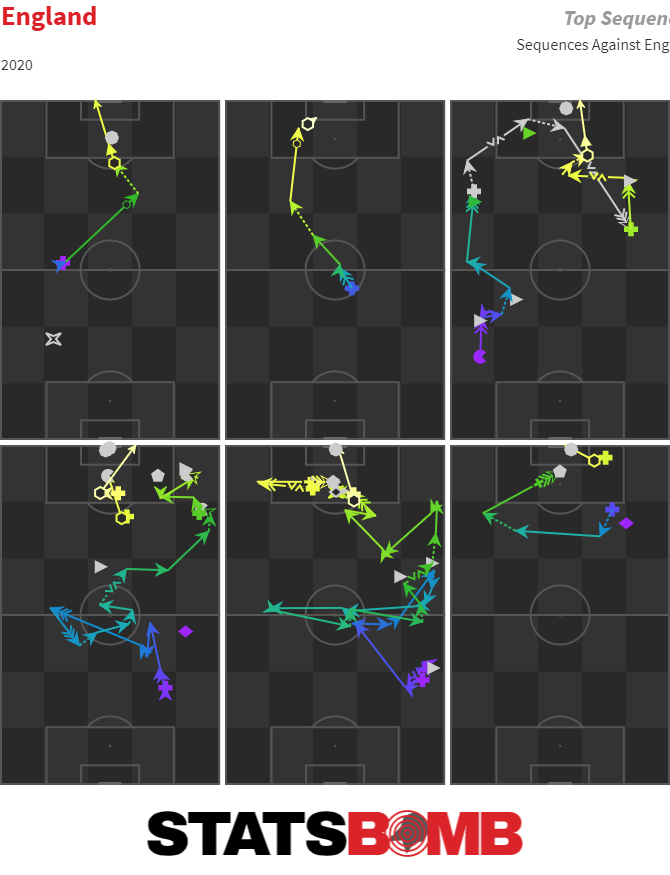 Set Plays:
Set Plays:
- Shots per Corner (3rd of 8)
- Shots per Indirect FK (4th of 8)
- Shots per Corner Conceded (4th of 8)
- Shots per Indirect FK Conceded (3rd of 8)
As in the 2018 World Cup, England’s set plays have been solid, scoring twice and conceding nothing from set-piece situations so far. Defensively they’ve been very stingy, winning first contacts on all but one of the corners played into the central zone.
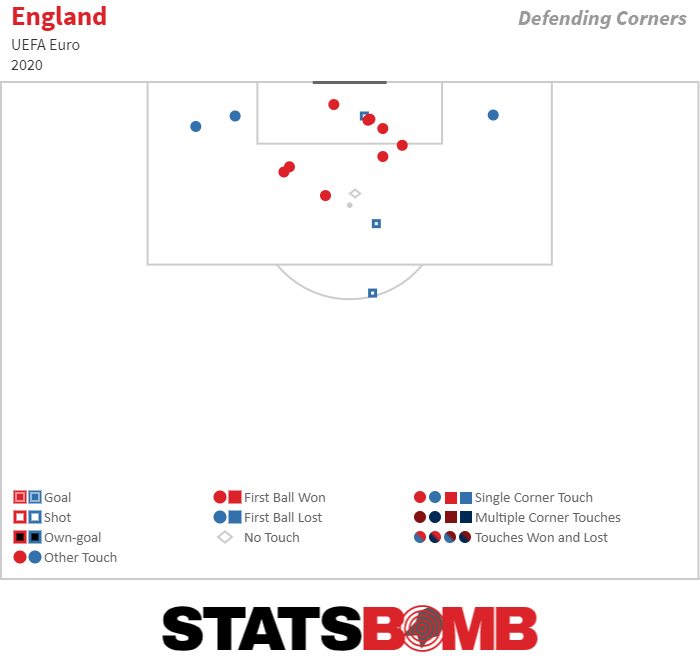
Denmark:
- xG (3rd of 8)
- xG/shot (5th of 8)
- Shots (3rd of 8)
- Counter Attacking Shots (2nd of 8)
- High Press Shots (1st of 8)
- Box Cross % (3rd of 8)
- Pace To Goal (2nd of 8)
- Directness (1st of 8)
Denmark’s tournament got off to a tricky start, but they find themselves in the semi-finals and attracting plaudits for their approach, playing with energy and aggression both in and out of possession. They lost their opening two fixtures to Finland and Belgium, but the signs were always there that they could be a threat at Euro 2020: they won the shot count 42-7 across the two games and were unfortunate not to come away with at least one win.
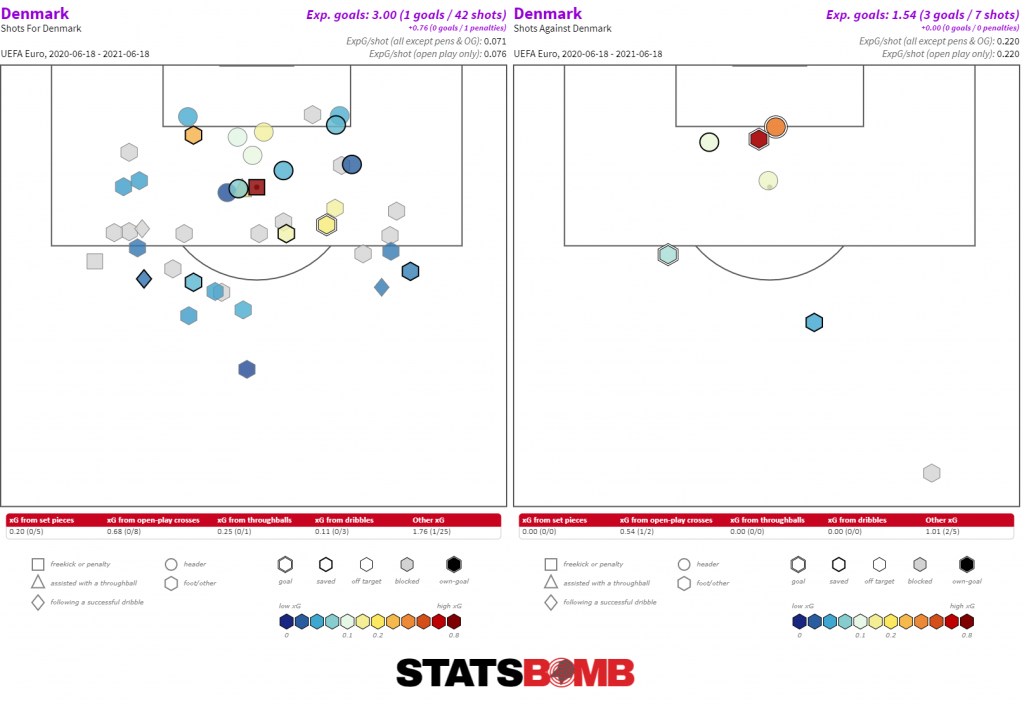
As if they were wearing their boots on the wrong feet, but either way, they found their scoring touch before it was too late, scoring ten goals from their next 43 shots to sweep aside Russia, Wales, and the Czech Republic to reach the semi-finals. Contrary to England, Denmark have looked to attack quickly and directly. Their Pace To Goal of 2.8m/s and Directness rating of 0.90 – a ratio of the distance towards goal at the start of the possession, divided by the total distance travelled in the build-up - reflect the verticality with which Denmark play, as does the number of opportunities they create on the counter, with 2.4 counter-attacking shots per game.
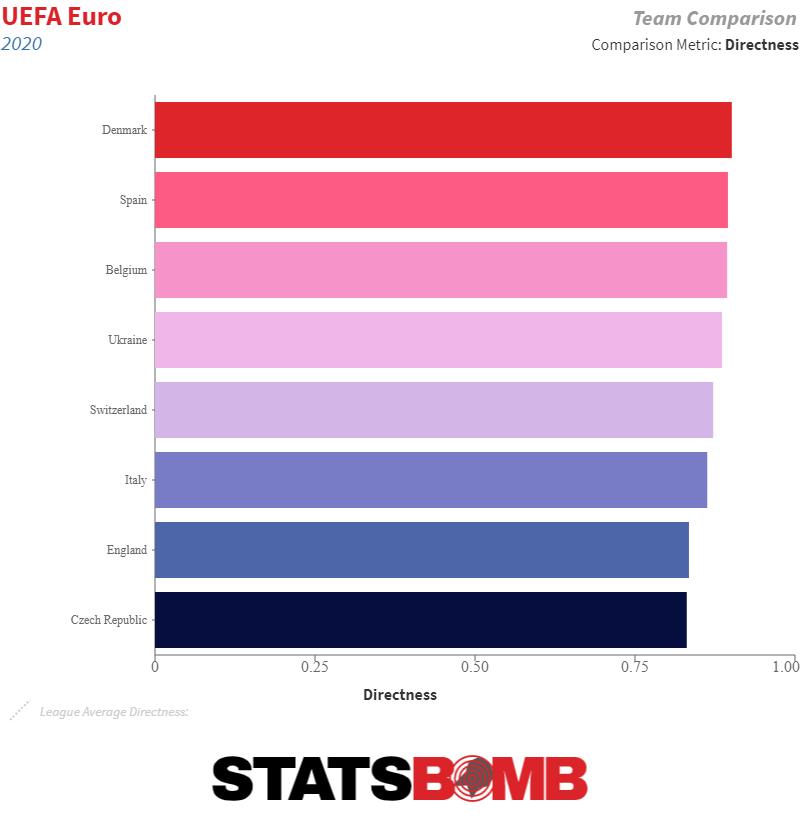
There are two key players to Denmark’s possession: Pierre-Emile Højbjerg and Joakim Mæhle. Højbjerg has taken on the chief playmaker role in the centre of the Denmark midfield, receiving the ball from the centre backs and distributing it wide to the advanced wing backs or into one of the front three of De rød-hvide’s 3-4-3. Højbjerg leads the Danish team for ball progressions to the final third (45) and has also made the 2nd-most passes within the final third (82).
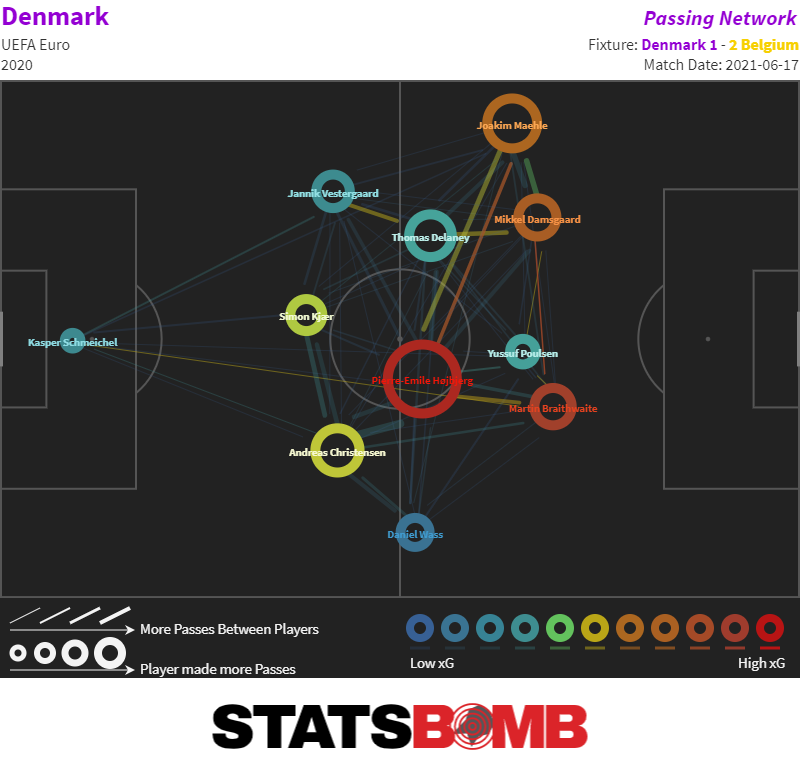
Joakim Mæhle’s performances down the left have received huge credit, offering width to Denmark’s attacks. In our recent article on our Similar Player Search tool, he appeared in our search for lateral defenders with a similar output to Trent Alexander-Arnold, and his performances showed up well according to our possession value model, On-Ball Value.
He’s been a critical outlet for the Danes, with 29 final third receptions, second only to Martin Braithwaite in the Denmark squad.
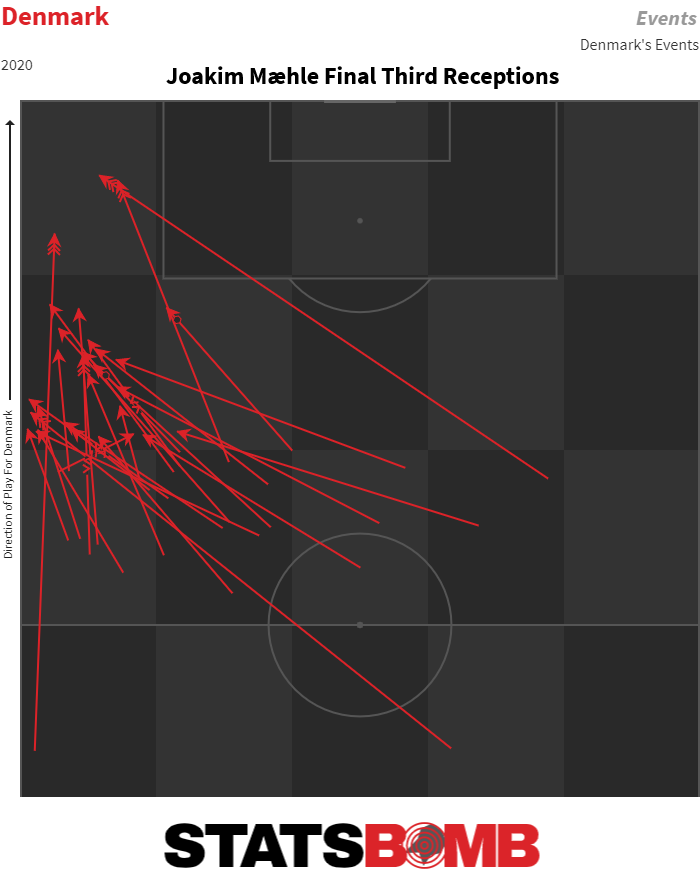
Defensive Approach:
- xG Conceded (3rd of 8)
- xG/shot Conceded (5th of 8)
- Shots Conceded (3rd of 8)
- Counter Attacking Shots Conceded (6th of 8)
- High Press Shots Conceded (4th of 8)
- Clear Shots Conceded (6th of 8)
- PPDA (2nd of 8)
- Defensive Distance (2nd of 8)
- Aggression (7th of 8)
- Pressures In Opposing Half % (4th of 8)
Defensively, Denmark have proven difficult to break down. They’ve conceded five goals, but three of those were in their opening two defeats and since then they’ve outscored the opposition 10-1. Their 3-4-3 provides a lot of central cover: the wide forwards Damsgaard and Braitwaite tuck in to take up a narrow position out of possession to help Delaney and Højbjerg in the middle and as a result, Denmark are able to defend in a higher block with an emphasis on crowding the central channels.
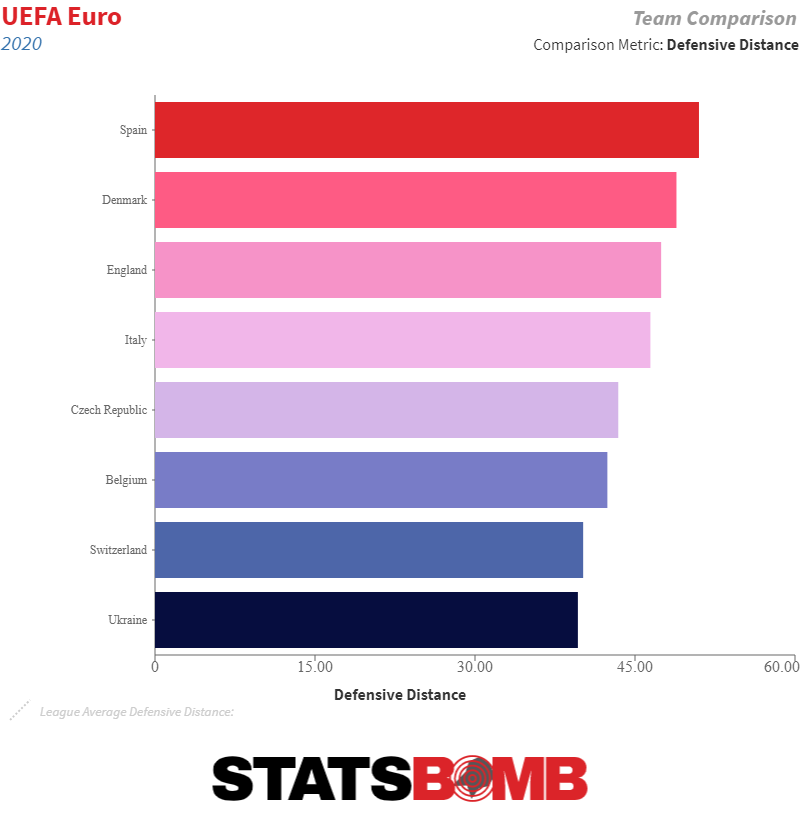
Their higher defensive line coupled with their lower Aggression % (the percentage of opposition ball receipts that are pressured, tackled, or fouled within 2 seconds) of 18% highlights that they prefer to retain their shape. Denmark position themselves higher up the pitch and then funnel the opposition into areas where they know they can apply heavier pressure, squeezing their opponents against the touchline and forcing the play backwards or regaining possession through a turnover.
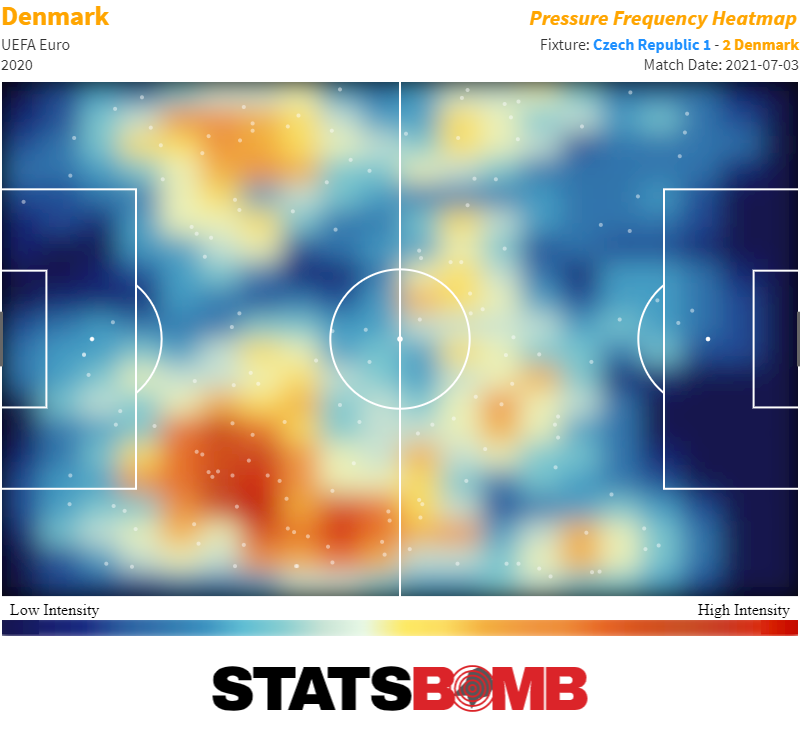
What To Expect
With Denmark lining up in a 3-4-3, it remains to be seen whether Gareth Southgate will mirror that shape, as he did to great effect versus Germany, or stick with the same XI and 4-3-3 that breezed past Ukraine in the quarters. Denmark also have food for thought having taken a front-foot approach to their matches so far - will they play a more conservative game in a high stakes match, in what could also be classed as an “away” fixture at Wembley?
That’s just an overview of the various insights that can be drawn out of StatsBomb IQ. Teams and federations continue to source match-winning insight out of our analytics platform and data to give them an edge on matchday. For a full demo of the platform, contact us today.
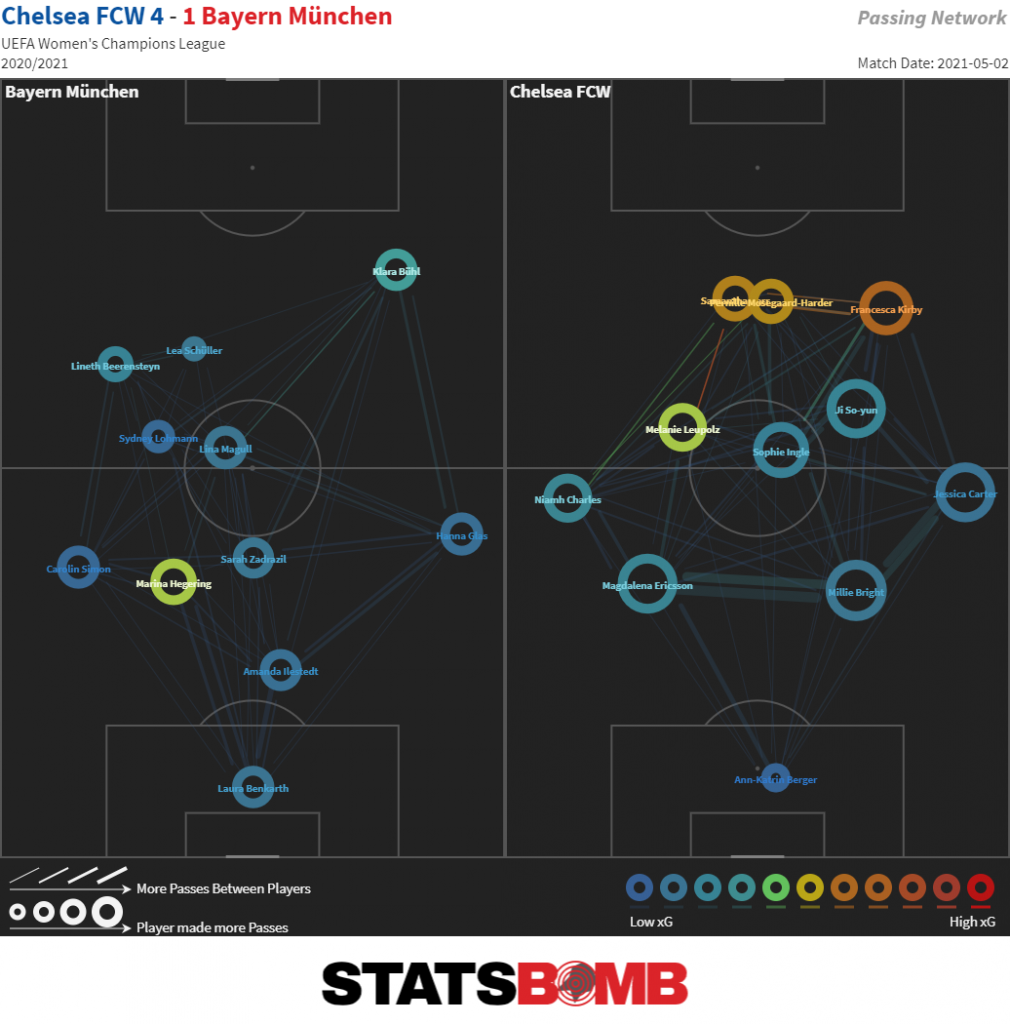
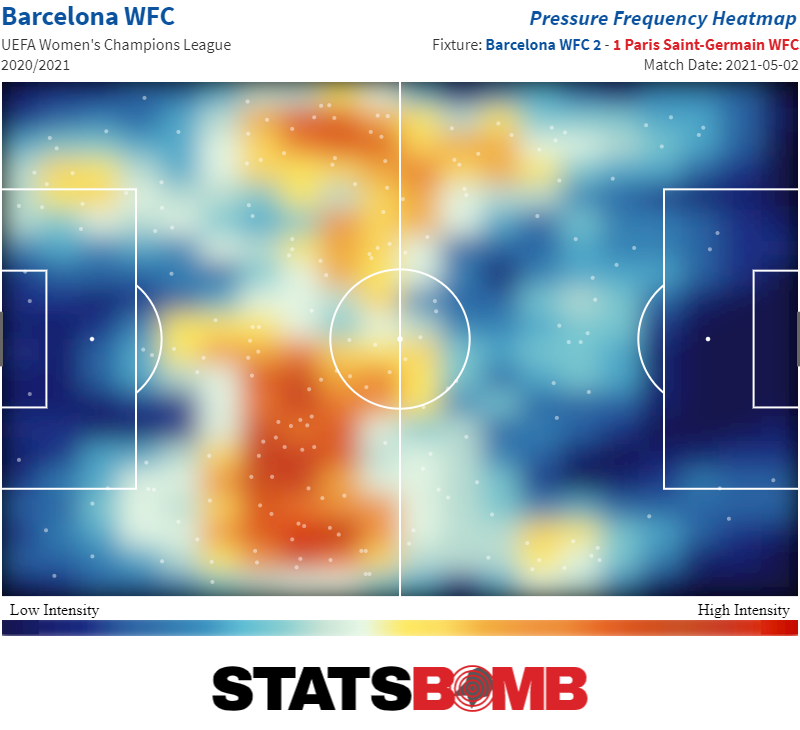


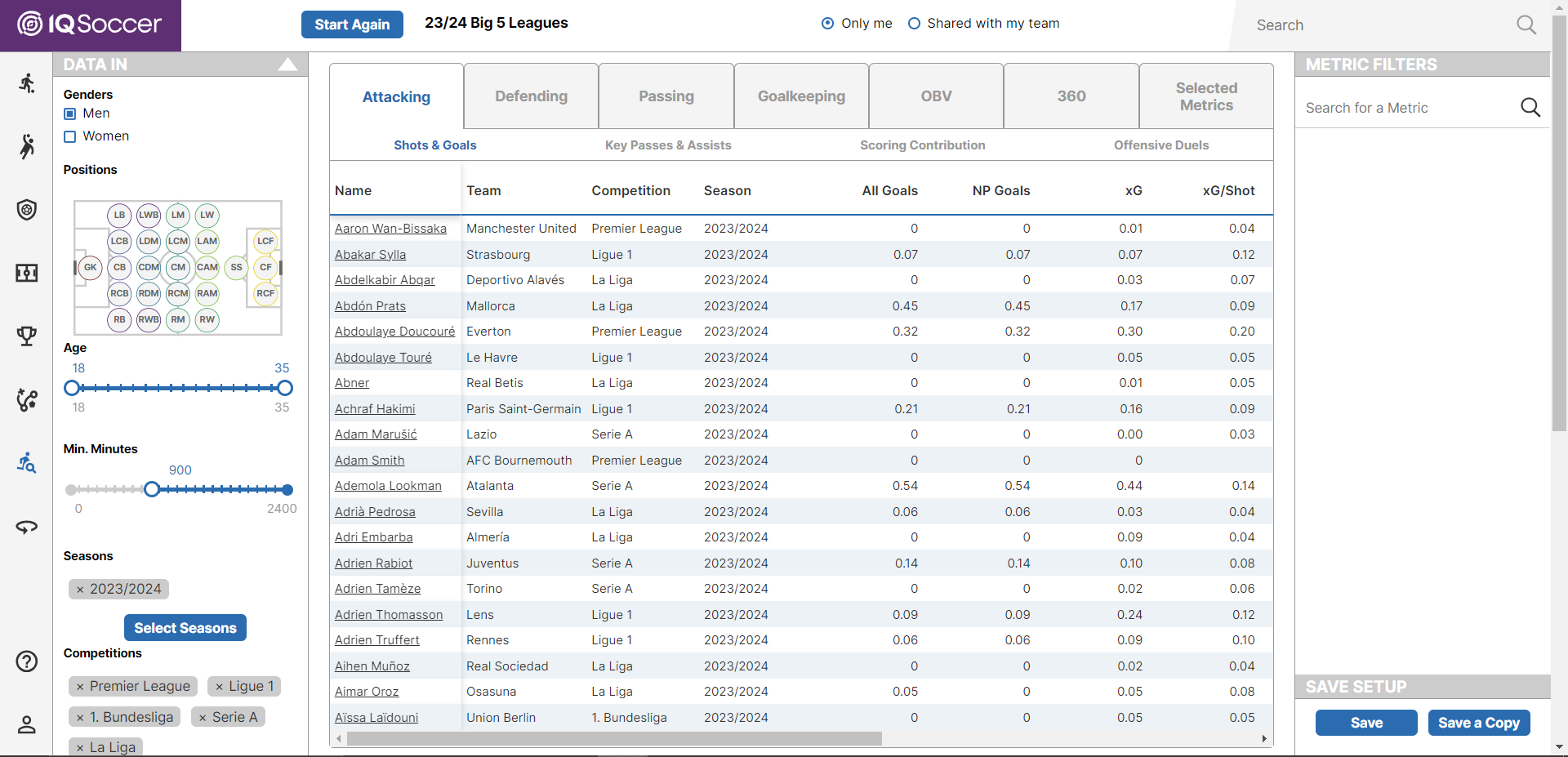
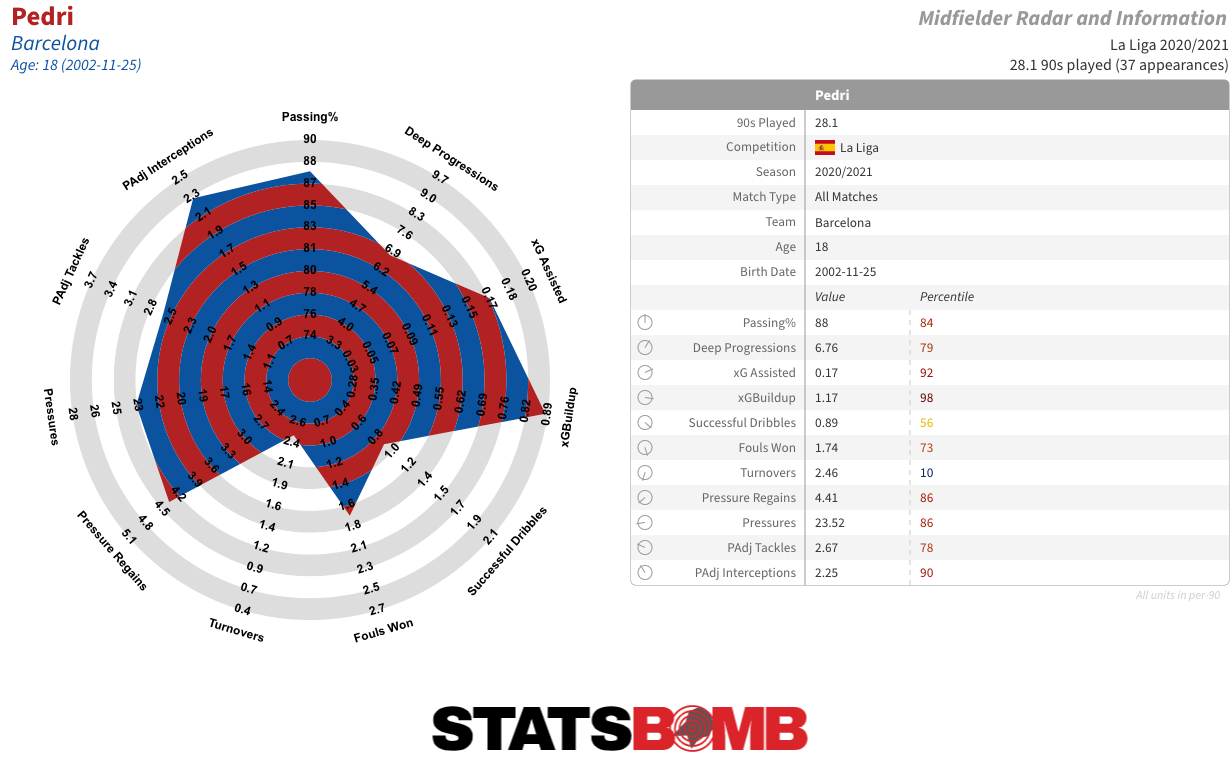








 Defensive Approach:
Defensive Approach:

 Set Plays:
Set Plays:





